Search for an Artist
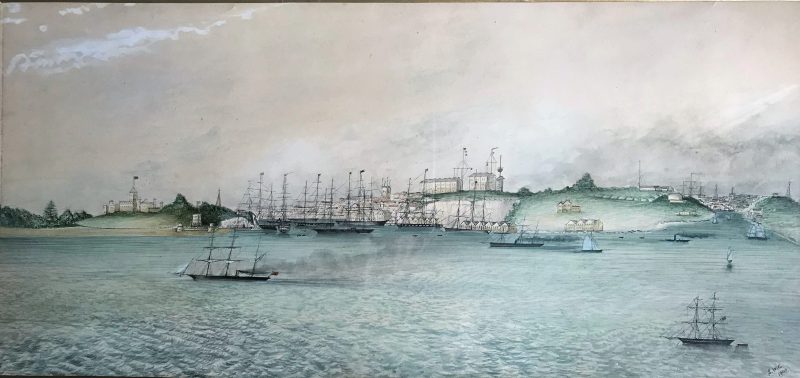
Watercolour of Sydney Cove dated 1866 and signed S.W.C
On a blustery, overcast morning[1] in 1866, an amateur artist set up their easel on the veranda of one of the impressive villas at Kirribilli Point, Sydney. Just eighty years previously, the view would have been of sporadic campfires lit by the indigenous Gadigal people. Now, Sydney Cove was a bustling commercial and administrative hub for the colony of New South Wales. In Circular Quay, many ships can be seen docked and to the right hand side of the painting you can see the paddle wheel ferry Waratah, midway between Circular Quay and Milsons Point.
This is the story of the search for the identity of the artist “SWC” and their possible connection to Fredrick Lassetter who owned a large, well known hardware business in Sydney, the Beauchamp family and perhaps also to Elizabeth von Arnim, a famous European author in the early 20th century.
In the late 1970s, the painting surfaced in an antique shop on Portobello Road, London. There was no information about the art work, other than it was dated 1866 and signed S.W.C. The current owner recognised that the subject was Sydney Cove and, after some deliberation (and haggling), the painting was purchased.
Close inspection of the painting shows a lot of detail in the rigging of the ships and in depictions of buildings in the background. Foreground and background perspectives are slightly off indicating a primitive or naive artist. However, familiar buildings around Circular Quay can be clearly recognised giving it a historical significance. Government House, Fort Macquarie, Sydney Observatory, Campbell’s Stores and other landmarks are able to be identified (Appendix 1 for further information).
Experts who have reviewed the painting noted that it was “fresh, observant and evocative”. Nevertheless, they had no doubt that it was by a primitive or naive hand and not a professional artist. During the 19th century in particular, there were many who made paintings purely for pleasure, with little or no instruction. They had no ambition to formally exhibit or belong to any society by which their identity might be recorded. The artists do however, contribute to the great visual treasure trove recording the era in which they lived.
Location of the Artist
The location of the artist was determined by triangulation of three prominent landmarks seen in the painting. See Appendix 2 for analysis. There were only a few houses on Kirribilli Point at that time which allows us to pinpoint the location to either Beulah House or Clifton. The perspective from houses to the left or right of these dwellings would have meant that the three reference buildings would not have lined up how they appear in the picture.
Beulah House was built in the 1840s by William Gibbs. His father Colonel John Gibbs (Collector of Customs) built the nearby Watonga in 1843. William Gibbs was arrested in 1858 on smuggling charges and sentence to 2 years prison. Beulah House was sold as part of insolvency proceedings in the early 1850s.
Clifton was built in the 1840s for the Port Jackson Harbourmaster, Merion Moriarty. It was high up so provided a commanding view of the harbour. It is noted that the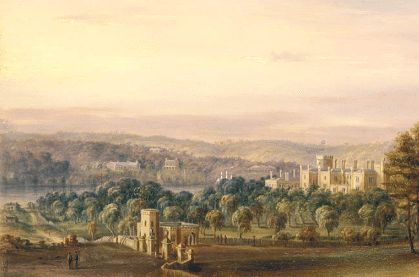 SWC painting does seem to suggest some elevation for the artist.
SWC painting does seem to suggest some elevation for the artist.
In this detail from G E Peacock’s painting of Government House[2] from Ca 1850, Beulah House can be seen on Kirribilli Point towards the left. Woodlands is close by on the right and above Woodlands is Clifton House. The only building that is still exists is Watonga, at the far right, which is now known as Admiralty House and is the Sydney residence of the Governor General.
The Lassetters and Beauchamps in 1866; Occupiers of Beulah and Clifton
To find a link to SWC, I looked into who lived at Beulah and Clifton in 1866. In 1866 Beulah House was owned by Captain AW Riley and leased to Fredrick Lassetter. The Lassetters moved from Beulah to nearby Watonga in the second half of 1866.
Further up the hill behind Beulah, was Clifton which was owned by James Tucker and leased to the Beauchamp family while Tucker was away on a trip to England. Sometime in late 1866 or 1867, the Beauchamps moved to the Lassetters’ old residence, Beulah.
The Beauchamp and Lassetter families are connected through marriage. Henry Beauchamp married Fredrick Lassetter’s younger sister, Elizabeth (known as Louey), in 1855.
Fredrick Lassetter was a very successful businessman. His company, F. Lasseter and Co, became one of the largest department stores in Sydney employing over 1000 workers. His son, General Henry (Harry) Beauchamp Lassetter commanded the New South Wales Mounted Rifles in the Boer war.
In a 1925 interview, Fred’s son, General HB Lassetter described Kirribilli in the 1860s as a small community. Campbell St (present day Kirribilli Ave), was a “lane infested with cows and once or twice by a wild bull”. Indeed, General Lassetter tells a story from 1866 when his father and aunt (probably Louey Beauchamp) were chased by a bull and only escaped with the assistance of a gardener who drove the animal into a paddock at Beulah.
Henry H Beauchamp was a successful merchant and great speculator (as described by HB Lassetter). Their youngest daughter, Mary Annette Beauchamp was born on 31 August 1866 and is better known as the author, Elizabeth von Arnim. Von Arnim’s most famous work is “Elizabeth and her German Garden”. A cousin of Elizabeth von Arnim’s is the New Zealand author Katherine Mansfield. The birth notice in the Sydney Morning Herald for Mary Annette, mentions that Mrs Beauchamp gave birth “at her residence”. Perhaps this was at Clifton (they were about to move) or at an un-named residence they may have lived at between Clifton and Beulah.
Both the Lassetters and Beauchamps later travelled to London. The Lassetters in 1869 and the Beauchamps in 1870. The Beauchamps auctioned off all their Sydney possessions (including a “very quiet and good Milch Cow”) and remained in Europe. The Lassetters on the other hand, returned to Sydney after a year abroad and eventually 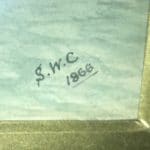 moved to Redleaf in Double Bay (now the Woollahra Council Chambers).
moved to Redleaf in Double Bay (now the Woollahra Council Chambers).
Unfortunately I haven’t been able to find the initials S.W.C. associated with anybody in the Lassetter or Beauchamp families, their extended families, attendants at the birth of Mary Annette Beauchamp, others living on Kirribilli Point or indeed through the Sands directory, anyone in Sydney. The search continues, but by posting this article, I am hoping someone might recognise the painting or initials.
Conclusion
I started this with just the painting, the initials and a date. Through the course of trying to identify S.W.C., I have had a fascinating journey into Sydney’s North Shore during colonial times. My research into who lived in Kirribilli in 1866 led me to the rich history of the Beauchamp and the Lassetter families as well as stumbling onto another puzzle. The birth place of Mary Annette Beauchamp, the future Elizabeth von Arnim. My theory on her birth place (Clifton House or at an un-named residence between Clifton and Beulah) is based on newspaper articles and piecing together who lived where and when but there are gaps. Other theories are at least equally plausible. Mary Annette’s birth certificate mentions that she was born at Kiribili (sic) Point and there are a limited number of residences where this could be.
Through this project, I have reflected on the link 1866 has with my own ancestor who arrived in Sydney on a convict ship in 1822 (transported – 7 years under the UK’s Irish Insurrection Act – for being outside after curfew) and died near Cowra in the central West of New South Wales in 1866. By the time he died, he owned some 5000 acres, growing wheat, cattle and sheep. He employed 30 men, had built a school on his land and was a leading figure in the district. The colony of New South Wales was certainly a land of opportunity for those willing to work for it.
In my research, I have also had to think about how the painting found its way to Portobello Road in London. It is perhaps too romantic a notion, to think that the painting was by a friend or domestic staff of the Beauchamps, and that they took it back to England with them as a memory of their view from Beulah.
John Murray
Sydney August 2019
00000000000OOOOOOOOOOOOOO000000000000
APPENDIX ONE: Identification of Landmarks.
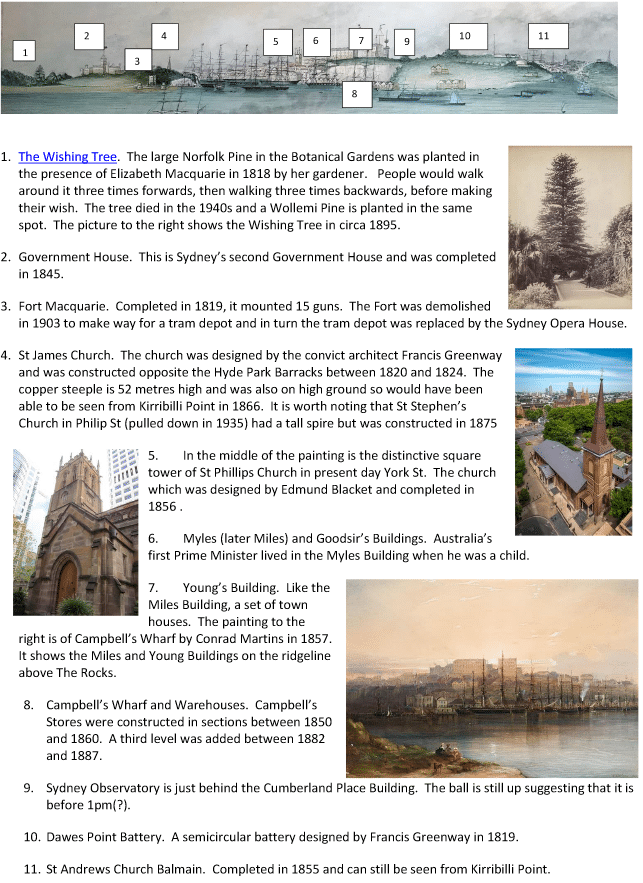
**************************************************
APPENDIX TWO: Location of the artist.

Most likely location for the correct perspective in the painting is Beulah House or Clifton House. If from The Dingle, Government House would have been more behind Fort Macquarie. If from Woodlands, St James Church would be behind Fort Macquarie and the wharf to the right of Fort Macquarie would not have been as visible.
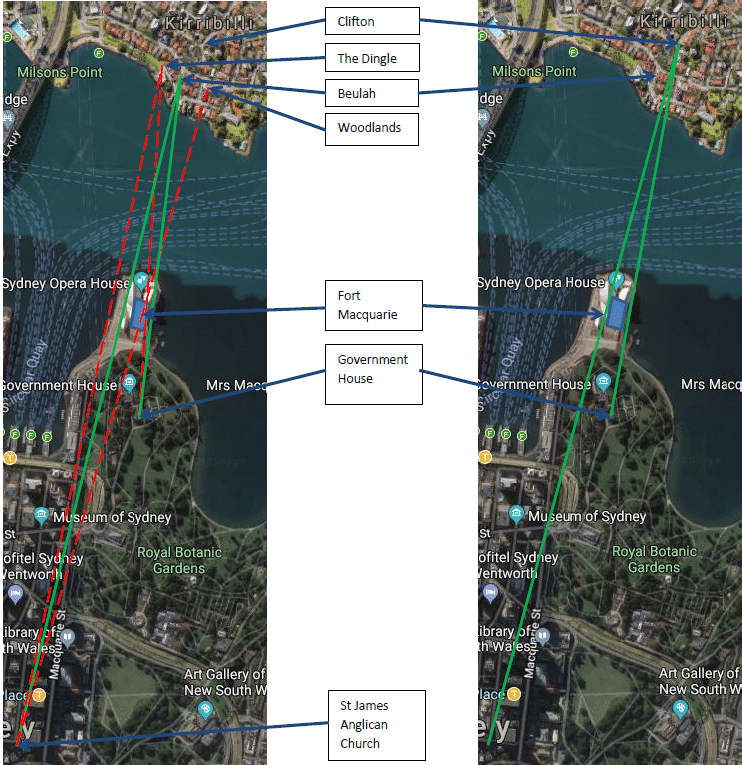
***************************************************************
APPENDIX THREE: The Lassetters and Beauchamps and their links to Woodlands, Clifton, Beulah House and Watonga
The first evidence of the Beauchamps at Woodlands is May 1863 when their son was born
On the 18th May, at Woodlands, the wife of Henry H. Beauchamp, of a son.[3]
The next Family Notice is in January 1863 for the birth of another son
On the 30th December at Woodlands, North Shore, the wife of Henry H. Beauchamp, of a son.[4]
It seems that the Beauchamps moved out of Woodlands in the first half of 1863. On 27 June 1863 there is a birth notice for a daughter born June 25 to the wife of Mr John Davies at Woodlands. From notices in the Herald, the Davies were living at Woodlands until about 1867. Given the Beauchamps moved out of Woodlands in the first half of 1863 and could not have moved to Clifton until after February 1864, there is a bit of a gap about where they lived. I have not looked into it.
From information put together by North Sydney Library, Clifton was probably built for Merion Moriarty, Harbourmaster for Port Jackson from 1842-1857. It was for sale in December 1851 and was perhaps purchased by William Tucker at that time. Certainly William Tucker was living at Clifton by 1854 as there was a Death Notice in September of that year in relation to his son. In the 1860s, there continued to be Family Notices and Advertisements in the SMH linking Tucker to Clifton.
On 10 November 1863, Clifton was advertised ‘To Let’. Subsequently, there was an advertisement for an Auction of Household goods at Clifton to take place on 5 February 1864. The advertisement for the auction noted that Mr Tucker will be departing for England on the Duncan Dunbar. The Duncan Dunbar departed for London on 11 Feb 1864. The Beauchamps were living at Clifton by August 1864. There is a Family notice in the SMH dated 5 September 1864 noting the birth of a son.
Births – On the 23rd August, at Clifton House, North Shore, the wife of Henry H. Beauchamp, of a son.
Other notices for the Beachamps at Clifton are in April 1865 for a respectable girl as an ‘under nurse’ and by Mrs Beauchamp in June 1865 for a Governess to proceed to Christchurch New Zealand. The last entry I can find on the Beauchamps at Clifton is a letter to the editor that Henry wrote on 12 October 1865 (published 13 October). He was commenting on two ladies that he saw knocked down by a speeding Waverly omnibus.
William Tucker returned to Sydney in November 1866. Shipping records show that he arrived on the Mataura in Melbourne at the end of October. The Mataura was going on to Sydney but the family changed to the City of Adelaide which got to Sydney on 1 Nov, just 5 days earlier than the Mataura. The Tuckers had moved back into Clifton by June 1867 as evidenced by a wedding notice for William Tucker’s daughter.
On 29th May, at St. Thomas’s Church, Willoughby, St. Leonards, by the Rev. W. B. Clarke, GEORGE FREDERICK DANSEY, Esq., of Wynyard-square, second son of John Dansey, Esq., of Blandford, Dorset, England, to ALICE MARGARET, second daughter of WILLIAM TUCKER, Esq., of Clifton, North Shore.
From the newspaper articles, I can’t tell when the Beauchamps moved out of Clifton. The Tuckers we back in Sydney in November 1866 and may have given plenty of notice of their return. Pure conjecture but the Beauchamps may have needed to move somewhere else on Kirribilli Point until Beulah became available in the second half of 1866.
Beulah House
William Gibbes built Beulah House in 1840s. His father Colonel John Gibbes (Collector of Customs ) built Watonga (Admiralty House). William Gibbes was declared insolvent in the early 1850s and was arrested in 1858 on smuggling charges and sentence to 2 years Prison.
Captain A.W. Riley of the 86th (or 80th or 10th) Regiment owned Beulah House in the late 1850s and was living there by March 1858 (Birth notice). In December 1860, the house was put up to be sold or let. Interested parties were asked to apply to Captain Riley on the premises. It seems that the property was not sold but rather leased to the Lassetters and then Beauchamp families. The Rates Book for East St Leonards in 1889 (the earliest the North Sydney Library Local History collection has) show HH Beauchamp living at the house and that it was still owned by Captain Riley.
The first instance I can find of the Lassetters at Beulah is in September 1861. There was a Birth Notice for a son to Mrs Lassetter who was born on 12 September 1861 In succeeding years there were other Family Notices and Advertisements linking the Lassetters to Beulah. In 1866, Mrs Lassetter advertised for a Laundress in January and then for a needlewoman in June. Both cases, interested parties were to apply to Mrs Lasseter at Beulah. There is nothing on the Lassetters until a December 1866 birth notice at Wotonga.
There are no newspaper notices or advertisements for Beulah House or Beauchamp (apart from business ones) until January 1868. In January 1868, Mrs Beauchamp was advertising for a needlewoman with applicants to call on her at Beulah, Kirribilli Point. There were other similar advertisements in January, July and October 1869. In December 1869 there was a preliminary notice in the SMH for an Auction of household goods at Beulah House “by order of HH Beauchamp esq who is leaving for England per La Hogue.” The auction was to take place on 4 January 1870. More detail on what was being sold was in later advertisements.
The Beauchamps sailed for London on La Hogue departing on January 11 1870. On La Hogue there was Mr and Mrs Beachamp, 7 children and servant. There was also a Rev M Lassetter on board La Hogue but Fredrick Lassetter and family departed for London the year before (see below).
The present day Waruda Avenue would have just about gone through the middle of Beulah.
Watonga is the present day Admiralty House which is the official Sydney residence of the Governor General.
The Lassetters had moved from Beulah to Wotonga by December 1866. A birth Notice in the Sydney Morning Herald notes that Mrs Lassetter gave birth to a son at her residence Wootonga (as it was then known as) on 30 December 1866. In February 1869 there was a “To Let” notice in the SMH for Wotonga. The advertisement noted Wotonga as the present day residence of F Lassetter Esq who is leaving by the Parramatta for London.
The Parramatta left for London on 9 February 1869. In the Lassetter party, there was Mr and Mrs Lassetter, 6 children and 3 servants.